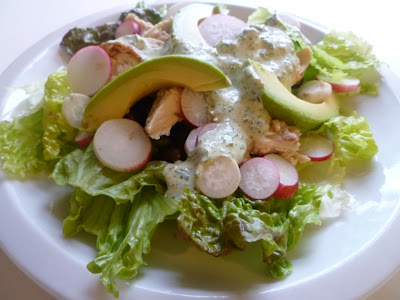Once you've tasted it, the combination of buckwheat and chocolate is kind of addictive. With some remaining buckwheat flour from Lonesome Whistle Farm, these buckwheat butter cookies with cocoa nibs caught my eye here and here. Cocoa nibs, I discovered, can be procured from the bulk spice section of the Market of Choice.
I don't have much patience for cookie cutters (unless baking for Santa), so I liked the option of rolling a log of buttery cookie dough and slicing it up. It felt like working with play dough, but the final product was downright sophisticated. The subtle nutty flavor of the buckwheat and the charming restraint of the cocoa nibs paired perfectly with a cup of tea and freshly picked strawberries. Enjoy these refined treats while fantasizing about the London Olympics, but by the end of the weekend our neighborhood will be back to normal and ready to host the world famous Fairmount Neighborhood Farmers Market, starting July 8.
Buckwheat Butter Cookies with Cocoa Nibs
Adapted from Alice Medrich’s Pure Dessert
1 ¼ cups unbleached all-purpose flour
¾ cup buckwheat flour
½ lb. (2 sticks) unsalted butter, softened
2/3 cup granulated sugar
¼ tsp. salt
1/3 cup cocoa nibs
1 ½ tsp. vanilla extract
1. In a medium bowl, whisk together the flours.
2. With a handheld or stand mixer, beat the butter with the sugar and salt until smooth and creamy but not fluffy, about 1 minute. Add the nibs and vanilla, and beat to incorporate. Add the flours all at once, and beat on low speed until just incorporated. The mixture will seem very dry and pebbly at first, but keep beating, and it will slowly moisten and darken (as the buckwheat flour is absorbed) and come together. The dough will be very thick. You can also make the dough in a food processor, but incorporate the nibs at the end by hand.
3. Form the dough into a long (12” or 13”) log about 2 inches in diameter. Because the dough is so thick, I find it easiest to do this by pinching off hunks of dough from the bowl and lining them up on a large sheet of plastic wrap to form a log, then massaging and pressing them together to seal. Wrap well and refrigerate at least two hours, or overnight.
4. If you have refrigerated the dough overnight, remove it from the refrigerator about 30 minutes before you want to bake the cookies. Position racks in the upper and lower thirds of the oven, and preheat to 350 degrees Fahrenheit. Line two baking sheets with parchment paper or silicone liners.
5. When the dough feels slightly softened - it should have just a hint of give when you press it with a fingertip - unwrap it and place it on a cutting board. Using a thin, sharp knife, carefully cut the dough into ¼-inch-thick slices. Place slices on the prepared baking sheets, spacing each cookie about 1 ½ inches apart.
6. Bake until cookies just begin to color around the edges, about 12 to 14 minutes, rotating the sheet pans from top to bottom and front to back midway through. Transfer to wire racks, and cool the cookies on the baking sheets (or slide the parchment onto the rack to free up the pans). Cool completely before eating or storing. Repeat with remaining dough.
Store the cookies in an airtight container.
Yield: about 50-55 small cookies
Update: I experimenting with making a gluten-free version of these cookies using only buckwheat flour and I'm happy to report that they were extremely tasty.















